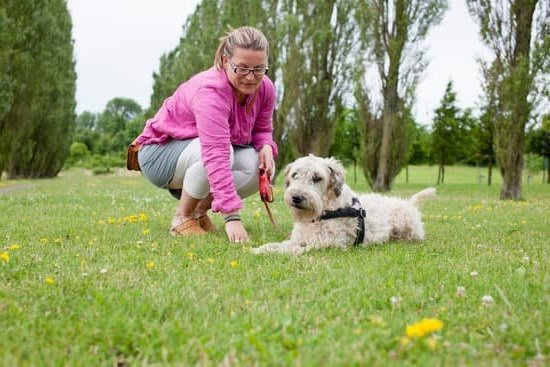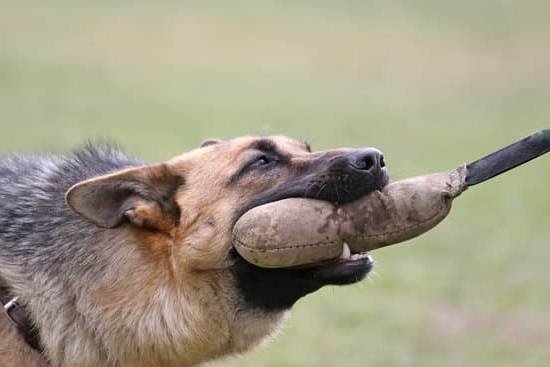Dog owners often wonder: can all dogs be trained not to bite? The issue of biting behavior is a major concern for pet owners, especially when it comes to the safety of family members and other animals. In this article, we will explore the root causes of biting behavior in dogs and address common misconceptions surrounding this issue. Understanding the factors that contribute to biting is crucial in determining whether all dogs can indeed be trained not to bite.
Biting behavior in dogs can stem from a variety of reasons, including fear, aggression, or pain. It is essential for dog owners to recognize warning signs and understand a dog’s body language to prevent potential biting incidents. We will delve into these factors and emphasize the importance of reading a dog’s cues to avoid confrontations that may lead to biting.
Additionally, the notion that certain breeds are inherently aggressive or more prone to biting is often misguided. Genetics does play a role in a dog’s temperament, but it does not determine their predisposition to bite. Debunking these myths is important in addressing the issue of whether all dogs can be trained not to bite. By understanding breed-specific considerations and debunking misconceptions, we can effectively approach training techniques for bite prevention across different breeds and individual dogs.
Understanding the Root of Biting Behavior
When it comes to addressing the issue of dog biting, it is essential to understand the underlying reasons behind this behavior. Dogs may resort to biting for various reasons, including fear, pain, protection of resources, or even playfulness.
It is crucial for dog owners to be able to recognize their pet’s body language and warning signs to prevent potential biting incidents. By understanding the root causes of biting behavior in dogs, owners can take proactive steps in training and prevention.
To gain a deeper understanding of why dogs bite, it is important to consider the role of genetics and breed-specific tendencies. While certain breeds may have a genetic predisposition towards being more assertive or protective, it is essential to debunk myths about specific breeds being inherently aggressive. Every dog is an individual with its own unique personality and behavior traits. It is important not to stereotype based on breed alone.
In addition to genetics, environmental factors and past experiences also play a significant role in shaping a dog’s behavior. Socialization and exposure to different environments at a young age can help prevent biting incidents by building the dog’s confidence and comfort around unfamiliar stimuli.
Moreover, incorporating obedience training using positive reinforcement methods can further reinforce bite inhibition in dogs and discourage aggressive behavior. Understanding the root causes of biting behavior in dogs is the first step towards effective training and prevention strategies that can help mitigate this issue among all breeds of dogs.
- Recognize the role of genetics in a dog’s tendency to bite
- Avoid misconceptions about certain breeds being inherently aggressive
- Consider environmental factors and past experiences as contributors to biting behavior
- Utilize socialization and exposure techniques for bite prevention
- Incorporate obedience training using positive reinforcement methods
Breed-Specific Considerations
Understanding a dog’s breed-specific considerations when it comes to biting behavior is essential for every dog owner. There are common misconceptions about certain breeds being more aggressive than others, but it’s important to debunk these myths and instead focus on the individual dog’s temperament and behavior. While genetics do play a role in a dog’s tendency to bite, it’s not the sole determining factor.
Certain breeds may have genetic predispositions that make them more likely to exhibit territorial or protective behaviors, but proper training and socialization can mitigate these tendencies. It’s crucial for dog owners to be aware of their specific breed’s characteristics and potential challenges when it comes to preventing biting incidents.
For example, breeds such as Rottweilers and Pit Bulls are often unfairly stigmatized as aggressive dogs, when in fact, they can be loyal and loving companions with the right upbringing. On the other hand, even breeds known for their gentleness, such as Labrador Retrievers, can exhibit biting behavior if not trained properly. It’s essential to approach each dog as an individual and address their unique needs regardless of breed stereotypes.
| Breed | Characteristics |
|---|---|
| Rottweiler | Loyal, strong-willed, protective |
| Pit Bull | Loving, energetic, intelligent |
| Labrador Retriever | Gentle, friendly, eager to please |
Training Techniques for Bite Prevention
When it comes to preventing biting behavior in dogs, there are various training techniques and methods that can be employed. It is important to note that while not all dogs may be completely rid of their biting instincts, proper training and consistent reinforcement can greatly reduce the likelihood of biting incidents. Here are some effective training techniques for bite prevention:
- Positive reinforcement methods: Utilizing positive reinforcement, such as rewards and praise, can effectively teach a dog bite inhibition. By encouraging gentle play and discouraging aggressive behavior, dogs can learn appropriate ways to interact with humans and other animals.
- Socialization and exposure to different environments: Exposing dogs to different people, animals, sounds, and environments from a young age can help them become more confident and less fearful. This can ultimately reduce the chances of defensive or frightened biting behavior in unfamiliar situations.
- Incorporating obedience training: Basic obedience training, such as teaching commands like “sit,” “stay,” and “leave it,” can be essential in preventing biting incidents. These commands not only establish your role as the leader but also give you control over your dog’s behavior in various situations.
By combining these training techniques, dog owners can effectively work towards minimizing the risk of their pets exhibiting biting behavior. Additionally, seeking guidance from professional dog trainers or behaviorists can provide further insight into tailored approaches for bite prevention based on a dog’s individual needs and temperament.
Working With Rescue or Older Dogs
Challenges and Considerations
Training adult dogs, especially those with a history of biting, presents unique challenges. These dogs may have had previous traumas or experiences that have shaped their behavior, making it crucial for trainers to approach the process with sensitivity and patience. It’s important to understand that older dogs may require more time and effort to unlearn unwanted behaviors and develop new habits. Additionally, rescue dogs may have trust issues due to past mistreatment, which can impact their response to training.
Techniques for Rehabilitation
When working with rescue or older dogs with biting issues, positive reinforcement is key. Building trust and a strong bond with the dog is essential in reshaping their behavior. This can be achieved through consistent training, rewards for good behavior, and creating a safe and nurturing environment for the dog. Patience is vital as progress may be gradual, but with dedication and understanding, it is possible to rehabilitate these dogs and help them overcome their biting tendencies.
Seeking Professional Assistance
For rescue or older dogs with severe biting issues, seeking the expertise of a certified dog trainer or behaviorist is highly recommended. These professionals have the skills and knowledge required to assess the specific needs of each dog and create tailored training plans. They can also provide guidance on managing challenging behaviors and addressing any underlying issues contributing to the biting behavior. Consulting a professional can significantly improve the success of rehabilitation efforts for rescue or older dogs.
Seeking Professional Help
When to Consult a Professional
While many dog owners can effectively address biting behavior through training and positive reinforcement, there are cases where seeking professional help is necessary. If a dog continues to exhibit aggressive or biting behavior despite consistent training efforts, it may be time to consult with a certified dog trainer or behaviorist. Additionally, if the biting incidents have resulted in serious injuries or legal implications, professional guidance is crucial.
The Benefits of Professional Guidance
Certified dog trainers and behaviorists have the expertise to assess a dog’s behavior and create customized training plans to address biting issues. They can also provide pet owners with valuable insights into the root causes of their dog’s aggression and offer guidance on how to modify the behavior effectively. Furthermore, working with professionals can provide peace of mind for dog owners, knowing that they are receiving expert assistance in managing their dog’s biting tendencies.
Cost Considerations
It’s important for dog owners to consider the financial aspect of seeking professional help for biting issues. While the cost of working with a certified trainer or behaviorist may be higher than DIY training methods, the long-term benefits often outweigh the initial investment. In some cases, consulting with a professional early on can prevent future legal liabilities and expenses related to dog bite incidents.
By recognizing when professional help is needed and being proactive in seeking assistance, dog owners can better address and manage their pet’s biting behavior while ensuring the safety of those around them.
Legal Responsibilities of Dog Owners
Understanding the legal implications and liabilities of a dog that bites is essential for all dog owners. In many places, there are laws in effect that hold the owner responsible for any damages caused by their dog biting someone.
This means that if your dog bites another person or animal, you may be held financially accountable for medical bills, property damage, and legal fees. Additionally, some areas have “one-bite” rules, which means that the owner may not be held liable for the first instance of their dog biting someone if they had no prior knowledge of their pet’s aggressive tendencies.
It is crucial for dog owners to take preventative measures to avoid biting incidents and adhere to local regulations. This can include properly socializing and training your dog, using leash and muzzle when necessary, and posting warning signs on your property if you have a potentially aggressive dog. Being a responsible pet owner also involves seeking professional help if your dog displays aggressive behavior despite training efforts or has a history of biting.
In addition to potential legal repercussions of a biting incident, it’s important to consider the emotional toll it can take on all parties involved. A bite incident can lead to trauma for the victim, as well as stress and anxiety for the owner. By understanding their legal responsibilities and taking proactive steps to prevent biting behaviors, dog owners can contribute to creating safer environments for both humans and animals alike.
| Legal Implications | Liabilities |
|---|---|
| Financial accountability for damages caused by a dog bite | Potential medical bills, property damage, and legal fees |
| “One-bite” rules in certain areas | Owner liability depending on prior knowledge of the dog’s aggressive tendencies |
| Preventative measures | Socializing, training, leash/muzzle use, and warning signs |
Conclusion
In conclusion, while the issue of biting behavior in dogs can be a cause for concern for many pet owners, it is important to understand that with the right approach and training, most dogs can be trained not to bite. By addressing common misconceptions about dog biting and understanding the root causes of this behavior, owners can take proactive steps in preventing biting incidents.
It is crucial for dog owners to grasp the reasons why dogs bite, as well as recognizing a dog’s body language and warning signs. Additionally, considering breed-specific considerations and seeking professional help when necessary are vital elements in effectively addressing and preventing biting behavior in dogs.
Furthermore, implementing training techniques such as positive reinforcement methods and obedience training, as well as properly socializing and exposing dogs to different environments, can significantly contribute to bite prevention. Ultimately, responsible ownership plays a key role in minimizing the risk of biting incidents, along with understanding the legal responsibilities and liabilities associated with a dog that bites. With proper education and mindful guidance, most dogs have the potential to be trained not to bite.
Frequently Asked Questions
Can a Dog Be Trained Not to Bite?
Yes, a dog can be trained not to bite through proper training and socialization. It’s important to start training a dog from a young age to understand bite inhibition and appropriate behavior with humans and other animals.
Positive reinforcement techniques, consistency, and patience are key in teaching a dog not to use its teeth in an aggressive or harmful way.
Can All Dogs Be Trained to Not Aggressive?
While all dogs can benefit from training, it’s important to recognize that some dogs may have genetic or environmental factors that contribute to aggression. Not all dogs will respond the same way to training methods and some may require more time, effort, and specialized techniques to address their aggressive tendencies.
It’s crucial for dog owners to seek professional help if they are struggling with their dog’s aggressive behavior.
Can an Aggressive Dog Ever Be Trusted?
Trusting an aggressive dog can be a challenging and ongoing process. Even with proper training and management strategies, there is always the potential for an aggressive outburst or negative behavior.
It’s crucial for owners of aggressive dogs to prioritize safety measures such as using muzzles, keeping the dog on-leash in public spaces, and avoiding situations that may trigger aggression. Working closely with a professional trainer or behaviorist can help owners understand their dog’s limitations and develop the best plan for managing their behavior safely.

Welcome to the blog! I am a professional dog trainer and have been working with dogs for many years. In this blog, I will be discussing various topics related to dog training, including tips, tricks, and advice. I hope you find this information helpful and informative. Thanks for reading!





